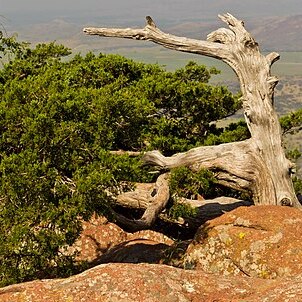Trees dioecious, to 15 m, single-stemmed to 1--3 m, occasionally branching at base; crown rounded to irregular and open. Bark brown, exfoliating in thin strips, that of small branchlets (5--10 mm diam.) smooth, that of larger branchlets exfoliating in strips. Branches spreading to ascending; branchlets erect, 3--4-sided in cross section, ca. 2/3 or less as wide as length of scalelike leaves. Leaves dark green, abaxial glands hemispheric, raised (particularly obvious on whip leaves), exudate absent, margins denticulate (at 20´); whip leaves 3--6 mm, not glaucous adaxially; scalelike leaves 1--2 mm, not overlapping or overlapping to 1/4 their length, keeled, apex acute to obtuse, spreading. Seed cones maturing in 1 year, of 1 size, with straight peduncles, ovoid to nearly globose, 6--9 mm, dark blue, glaucous, fleshy and resinous, with 1(--3) seeds. Seeds 4--6 mm. 2 n = 22.
More
A large shrub. It grows 9 m high and spreads 6 m wide. The trunk is often grooved and twisted. The bark is grey-brown. The crown is often cone shaped. The leaves are scale like and green. They are 1.5 mm long. They are mostly opposite and in 4 rows. The fruit are small and fleshy and have an aroma. They are deep blue when ripe. They have one seed. They are 8 mm wide.
Open grassland and shrubland, in sandy or rocky soil on plains, on bluffs and ridges, on hillsides or along stream beds in sandy or rocky soil, commonly over limestone; at elevations from 150-1,550 metres.
More
It mostly grows on limestone outcrops. It grows between 240-600 m altitude in the southern USA. It suits hardiness zones 4-9.
Can be grown by cuttings or seedlings. Seeds needs soaking.


